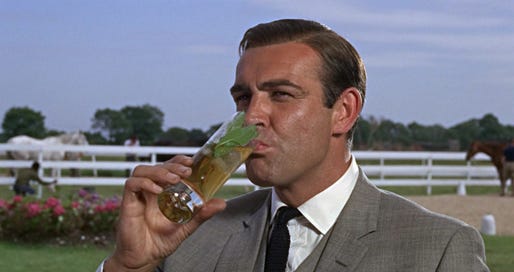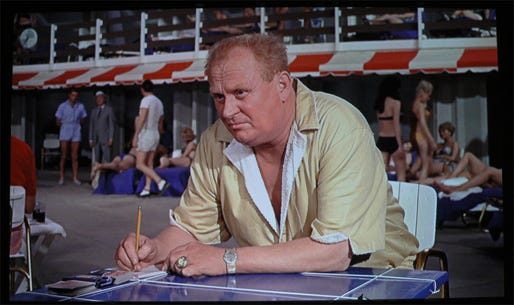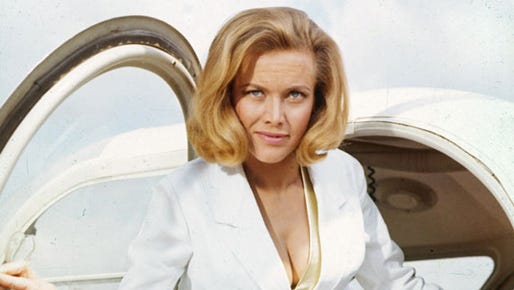You Only Live Twenty-Thrice: "Goldfinger"
“You Only Live Twenty-Thrice” is a look back at the James Bond films.
Each Friday until the release of the 23rd official Bond film, “Skyfall,” we will revisit its 22 official predecessors from start to finish, with a bonus post for the unofficial films in which James Bond also appears.
The 16th notes skittering in the trumpet section of John Barry’s orchestra are the first indicator that the James Bond of “Goldfinger” is a guy who’s loosened his collar.
Just as the iconic Bond theme feels jazzier, so does the series’ sleekest and swiftest entry to that point. The camerawork is smoother and steadier, namely in car chases that last longer and more noticeably exceed posted speed limits.
As a rousing introduction to the Aston Martin DB5, “Goldfinger” is all the advertisement the car company could have asked for. Who wouldn’t want a car that could corner like this and with some, well, “slight” modification, drop an oil slick on its pursuers?
There’s a surfeit of sex and travel; three is the magic number for Bond, who lands on the same number of continents as ladies. He also engages in rugged, violent combat with Oddjob, played by Olympic silver-medalist weightlifter Harold Sakata. This menacing Korean strongman with a (literally) killer hat kicked off the Bond tradition of idiosyncratically violent henchmen (and, yes, spawned another Austin Powers reference in the shoe-throwing Random Task).
And even then, Shirley Bassey’s brassy, ballsy title song had to feel like an instant-classic knockout.
Gone is the idea of Bondian vulnerability. However, “Goldfinger” swaps in a gaudier, glitzier subtext directly related to how this blockbuster took aim almost squarely at an American audience.
It’s no accident that Bond spends the brunt of this mission in the Bluegrass State. Neither is it pure happenstance that Bond’s perennial CIA pal Felix Leiter is portrayed as a relative lunkhead here — spying on bad guys in plain sight and snacking on Colonel Sanders’ chicken rather than vigilantly pursuing Oddjob. And check out the oddly specific statistic that the titular villain pulls out of thin air as Bond confronts him with a body count he plans to compile at Fort Knox.
Bond: “You’ll kill 60,000 people uselessly.”
Goldfinger: “Ha! American motorists kill that many people every two years!”
Goldfinger is clearly taking a dig at the United States’ inability to self-police its own safety. And with his plan to irradiate the gold at Fort Knox — thereby rendering it useless and his stockpile of bullion the world's most valuable — he intends to crush us whole.
It isn’t enough that Bond saves our nation in “Goldfinger” and becomes as much our hero as the Queen Mother’s. He upholds our worth, our heritage and our global dominance … all the things a hero would do for a film specifically intended to do gangbusters in America.
Also, a throwaway line about the Beatles suggests that, in 1964 — the height of America’s interest in British pop-culture imports — the Bond team wanted their man to please please us the most. “My dear girl. There are some things that just aren’t done,” Bond quips to the doomed Jill Masterson (Shirley Eaton). “Such as drinking Dom Perignon ’53 above a temperature of 38 degrees Fahrenheit. That’s as bad as listening to the Beatles without earmuffs.” The Bond squad would, of course, go on to embrace the band, or at least one of them, rather famously with another of the greatest Bond themes.
Ours isn’t the only America whose back Bond has in “Goldfinger,” either. In the pre-credits sequence (paid grandiose homage 30 years later in “True Lies”), Bond blows up a South American heroin outfit.
If the face of Bonita, the duplicitous dancer, looked familiar, that’s because it’s the same actress who played Ali Kerim Bey’s impatient girlfriend in “From Russia with Love.” And Nadja Regin kicked off what would become a Bond motif well into the 1990s — recurrent actors turning up as completely different characters.
Certainly, there has never been a shortage of attractive, exotic bombshells or jowly, middle-aged character actors. So why use the same faces for different roles? Allow a bit of a digression from the specifics of “Goldfinger,” if you will.
Bond has raised feminist hackles since the moment he showed up, smacking bottoms, tossing women around and uttering many a demeaning double entendre. "You’d be surprised at all the wear and tear that goes on in the field,” he deadpans to Q here. Also in “Goldfinger,” his prowess alone seems sufficient to turn bad females good. And you’ll notice the preferred term has never been “Bond woman.”
But that’s the more obvious stuff. It seems far more odious and overtly sexist to literally give the same face and body a different name — not just objectified, but interchangeable. Surprisingly, this aspect of the recurrent-actor trend lasted all the way until 1983, after Maud Adams played her second Bond girl in “Octopussy.”
And what of the familiar faces in a revolving rotation of mid-level diplomats and attaches? In “The Living Daylights,” Joe Don Baker angrily emptied clips trying to kill Bond. Eight years later, he was a gregarious good-guy sidekick in "GoldenEye." And before becoming Bond’s quasi-ally in General Gogol, Walter Gotell played the brutish Morzeny in “Russia.”
Global politics are always undergoing tectonic shifts. And, in a roundabout way, this could be the Bond series' way of addressing that the face of a foe could one day be a friend … or vice versa.
There’s no doubt, however, about the rottenness of Auric Goldfinger (Gert Frobe), a smuggler who loves gold so much he has its chemical symbol embedded in his first name.
At first glance, Goldfinger seems like a small-potatoes schmuck for the likes of Bond, cheating poolside at gin in Miami with escort Jill’s help. But her death at Goldfinger’s orders provides an unforgettably vivid Bond image — her limp body “suffocated” by a coat of gold paint — and establishes Goldfinger as a psychopath to be reckoned with.
That ruthless homicidal rage goes a long way toward selling a physically unimposing gasbag as a formidable cretin. See, Goldfinger likes to talk. A lot. About every last detail of his plot. Over time, Roger Ebert has notably dubbed this the Fallacy of the Talking Killer — a now lazy device for a hero to get the drop on a chatty bad guy.
But all that talking is part of legitimate character development for Goldfinger, for whom arrogance outweighs acumen and flamboyance trumps logic. He’s one of few Bond villains in whom you can sense an inferiority complex crowding out common sense. Here's Exhibit A:
After sparing Bond thusly in Switzerland, Goldfinger flies him to America. Held captive at Goldfinger's Kentucky hideout, Bond begins secretly smuggling details of Operation Grand Slam (code for the Fort Knox plot) to Leiter. The exterior scenes in Kentucky feel peculiarly podunk, but production designer Ken Adam unveils a great room for Goldfinger that remains a jaw-dropping feat of practical carpentry to rival today's digitally dressed sets.
Bond also meets a love interest often lauded as one of the best. But really, outside of her name, there’s never been much reason to fondly remember Pussy Galore — or “Goldfinger’s personal pilot,” as she was named in toned-down American press materials.
Pussy is visibly older than Honey Ryder or Tatiana Romanova. And you initially believe actress Honor Blackman — a fetching forebear to Kathleen Turner, husky voice and all — when she says she’s immune to Bond’s charms. But Pussy is unnecessarily spayed once she and James trade blocky, oh-so-westernized judo moves in a barn, complete with yuk-yuk orchestral aspects straight out of “Green Acres.”
By virtue of that literal roll in the hay, Pussy switches allegiances — ditching the gas with which Goldfinger plans to poison Fort Knox’s troops using the planes of Pussy’s all-female flying team. And that’s less absurd than Ian Fleming’s source novel, in which Pussy is apparently a lesbian whom James converts.
And what befalls Goldfinger once his plot is foiled? Oh, just your routine loss of cabin pressure.
“Goldfinger” leaves a smoking gun beside the body of the careless, fallible Bond we’d come to know up to this point. But it killed off that part of 007 so that another could live for most outings over the next 40 years — the glib, gun-toting embodiment of cool, who's always in control and always willing to go bigger each time out … just the way America likes it.
Next week: “Thunderball”
BULLET POINTS
At 38, Honor Blackman wasn’t just four years older than Sean Connery when “Goldfinger” began filming. She was, and still is, the oldest actress to ever play a Bond girl.
Fittingly enough, “Goldfinger” won the first of only two Oscars for any Bond film. Norman Wanstall took the award for Best Sound Effects Editing. The following year, John Stears won the Best Special Visual Effects Oscar for “Thunderball.” No Bond film has been nominated in any category since 1981’s “For Your Eyes Only.”
The Sneaker Pimps sampled a snippet of John Barry’s score to create the slinky undercurrent of their hit “Six Underground.” Coincidentally, that song was used in 1997’s “The Saint” — a modern film version of a TV show featuring Roger Moore, who would assume the Bond role in 1973.
Don’t think Harold Sakata really hits hard? Think again. Connery suffered a back injury in the scene when Oddjob knocks Bond out before killing Jill Masterson. Maybe that’s why producers decided to cut Connery a deal giving him 5 percent of the grosses of this and his remaining Bond films.
Prior to World War II, Gert Frobe was a member of the Nazi Party. Because of Frobe’s former affiliation, Israel banned “Goldfinger’s” release. Only after a family whom Frobe had helped hide from the Gestapo came forward to thank him for saving their lives was the film released there.





